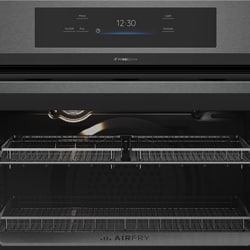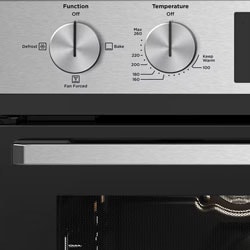1. Sizing
Kitchen Layout
When it comes to designing your kitchen, you need to think about how you like to cook. You want space and appliances to work more efficiently and with you, not against you. A few things to think about are the following.
CONSIDER YOUR CABINETRY
Are you looking to have a more traditional design with your cooktop and oven paired one under the other or are you wanting to give your kitchen a more modern design by having your oven in a tower layout? This could be a duo or double oven or a single oven by itself or paired with another oven or microwave. Positioning it close by your cooktop but far enough away means you could have two cooks in the kitchen, one taking care of the oven and the other the cooktop.
WORK TRIANGLE OR WORK ZONES
This choice will ideally come down to the size of your kitchen. When looking at a kitchen work triangle you would have your appliances configured so that the line drawn between the refrigerator, cooking appliances, and sink/dishwasher creates a triangle which the cook can easily and efficiently move about the space. Whether you have a small or large space you may look to have the area broken up into 5 zones, consumables, non-consumables, cleaning, preparation and cooking zones, this allows the space to work in unison.
PURPOSE OF YOUR ISLAND BENCH
Sinks are the most common element found in a kitchen island with a dishwasher to the side. As years have gone on the island bench has become the centre of the kitchen, it is the place where the work gets done and conversations with guests can happen.
Size of Oven
When shopping for a built-in oven, it’s important to consider all elements of its size. How much internal space do you need for your cooking style and how much space within cabinetry you have to work with will impact the external size of your new oven. Your range of options heavily depends on whether you’re replacing an existing oven or installing a new one from scratch. If you’re replacing, you are generally limited to a particular style and size of the oven.

60cm / 30 to 45 litres

70cm/ 45 to 70 litres

90cm / 70 litres or more
2. Fuel Type
Size, style and cooking functions are all important things that influence your final oven purchase decision, you will also need to consider whether you would like a gas or electric oven.

Electric Ovens
- More common than gas ovens.
- Generally provide more even heat distribution, especially when equipped with a fan.
- Require pre-heating, this process has become quicker with modern innovation.
- Generate drier air which can assist with crisping and browning.
- Majority of models need to be hardwired by a certified electrician; some ovens will come with a plug and lead suited to a particular amp rating.

Gas Ovens
- More expensive initial outlay then electric ovens; however, given energy efficiencies with gas cooking, they will cost less over their lifetime.
- Cook with greater moisture, making them ideal for cakes and roasts.
- Faster heating than electric models and more precise temperature control.
- Generally contain fewer parts then an electric oven, so the lifetime maintenance should be easier.
- Can run off natural gas or an LPG bottle - model dependent.
3. Types Of Ovens

Single Ovens
Ideal for
- Small family - large family
- Apartment living
- Rental properties
Capacity:
80 - 125L
Designed for ease and safety
Cooler to touch oven doors
Even cooking twin fan system
You set, we will do the rest
Tastier baking starts with steam
AirFry for that perfect healthy crunch

AirFry Ovens
Ideal for
- Families
- Apartment living
Capacity:
80 - 125L
Cook for the whole family
With air, not oil

Steam Ovens
Ideal for
- Small family to large family
- Apartment living
- Adventurous Cook
Capacity:
80 - 125L
Reheat leftovers with Steam
How it works?
Tastier baking starts with steam
Steam, our secret for delicious effortless cooking
Cleaning is a breeze with steam

Pyrolytic Ovens
Ideal for
- Small family to large family
- Apartment living
Capacity:
80 - 125L
Pre-cycle preparation
High heat
Cycle timing
Safety first

Side Opening Ovens
Ideal for
- Medium family
- Entertainer
Capacity:
Cooler to touch oven doors
Set your timer, we'll do the work
Family meals made easy
Place your shelves in with ease

Duo Ovens
Ideal for
- Medium family
- Entertainer
Capacity:
AirFry for that perfect healthy crunch
Cooler to touch oven doors
Designed for ease and safety
Ovens that clean up after themselves
Tastier baking starts with steam
You set, we will do the rest

Separate Grill Under Bench Ovens
Capacity:
Cooler to touch oven doors
You set, we will do the rest
Family meals made easy
Place your shelves in with ease

Separate Grill Wall Ovens
Ideal for
- Families
Capacity:
Cooler to touch oven doors
You set, we will do the rest
Family meals made easy
Place your shelves in with ease

Westinghouse Built in ovens
Westinghouse ovens are perfect for when you're cooking up a tasty roast for the family or putting your favourite recipe to the test. Find the right one for you, with features like AirFry, Roast +Steam and PyroClean, now you can cook healthier meals and we will help with the cleaning up.

Westinghouse ovens | TFT control panel
Using our oven’s TFT control panel is easier than ordering online food. Oven functions are grouped together to make selecting the right option faster and easier than ever. We even have 4 four options under AirFry to help you select the right one for the right food.

Westinghouse ovens | AirFry
Cooking for the whole family just got a whole lot easier. Our double AirFry tray lets you cook healthier meals straight from your oven with minimal oil. Plus, you don’t have to worry about turning your food, the heat comes from both above and below the tray, delivering perfect crunchy results.

Westinghouse ovens | Steam cooking
Bring out the bring out the natural flavours and goodness with natural flavours and goodness with our versatile steam functions. Steam Assist Cooking is ideal for meat. poultry and fish, ensuring an even cook from centre to surface with a crisp golden finish. You can use Roast +Steam to cater for your whole family and use Steam Reheat to use up all the leftovers.

Westinghouse ovens | EasyBake +Steam
Take your baking to the next level with our Easy Bake + Steam function. Steam helps you get a better rise, crispier crust, a fluffier centre and tastier textures for all your bread, pastries, cakes, and puddings.

Westinghouse ovens | Telescopic ovens
Telescopic runners are another piece of thoughtful design that makes it easy to draw racks out and safely check on your dishes during cooking.
4. Design & Other Considerations
WHITE, NATURAL OR DARK STAINLESS STEEL
A kitchen should feel timeless, using design elements and classic materials that will look good today and in a decade’s time. Whether you’re doing a complete renovation or replacing a single appliance, you can take your kitchen in a fresh new direction. With three options of finishes, you can look to a traditional white appliance or give your kitchen a modern update with natural or dark stainless steel.

White Stainless Steel

Natural Stainless Steel

Dark Stainless Steel
CONTRAST OR COMPLEMENT YOUR CABINETRY
Take into consideration what will work best with your chosen finish. For example, you could contrast dark stainless with lighter colours like bright whites or creams or complement with dark or stained wood cabinetry.
COORDINATE YOUR ACCESSORIES
From pendant light fixtures to a vase, it is important to think about what will be complemented by its surroundings.
CHOOSE FROM ONE BRAND
One thing to note when upgrading your kitchen is, just as there are 52 shades of white, same goes for appliance finishes. For best results, buy your appliances from one brand to make sure everything is seamless.
DIAL OR TOUCH CONTROLS
Whether you are some who likes to the feeling of turning a dial or prefer a touch control panel when setting your oven, there are a number of options to choose from. All designed to be sleek and simple to operate you'll have total control over your cooking temperatures, times and functions.
5. Warranty & Service
WARRANTY
Subject to terms and conditions our ovens come with 24 months warranty in Australia and New Zealand, following the date of purchase. Click here to view Terms and Conditions.
SUPPORT & SERVICE
We have a Customer Care team available to assist you over the phone during week days, and a national network of experienced technicians and selected service agents. Offering a fixed price guarantee with no additional hidden labour costs, giving you peace of mind that your appliance is in good hands.
6. Top FAQs
-
What is a Pyrolytic oven?
A pyrolytic oven is better known as a self-cleaning oven. By reaching a high temperature, you can save time, effort and minimise the need for cleaning chemicals. During the cycle the oven will reach a temperature of 300°C, which turns your grime into ash leaving you to just wipe clean. For safety the door will automatically lock at the start of the cycle until the oven has cooled down. With options of light or normal cleaning the run time can be between 1.5-2.5 hours excluding the cool down time.
Find out more about Westinghouse pyrolytic ovens here.
-
What is a Steam Oven?
A steam oven has a function that combines steam with hot air throughout the cooking process. Dependent on the level of steam the oven offers, steam ovens come with a water tank accessible from the front of the oven, that feeds water to the inside of the oven or there is a well at the base of the oven cavity in which you place water.
Find out more about Westinghouse steam ovens.
-
What is fan forced oven?
Fan forced oven has a heating element and a fan on the oven’s back wall. The electric element heats up and the fan circulates the warm air through all the levels of the oven evenly. The main benefit of a fan forced oven is the even temperature distribution, which allows several dishes to be cooked at once with no need to rotate.
Find out more in this guide to buying your new oven.
-
How do you clean your oven?
Depending on your oven model you can clean your oven following the three methods.
-
Self-cleaning
A pyrolytic oven is better known as a self-cleaning oven, you can save time, effort and minimise the need for cleaning chemicals, as it turns your grime into ash so you just need to wipe away. During a Pyrolytic cleaning cycle, the door will automatically lock when the temperature in the oven approaches 300˚C.
Find out more about Westinghouse pyrolytic ovens. -
Steam cleaning
Cleaning is a breeze with steam. A 30-minute light oven cleaning that's chemical-free. Just add water and vinegar, turn on the steam cycle and wait until the grime is softened and loosened. Grab a cloth, some detergent and wipe. Your oven is clean again. Easy.
Find out more about Westinghouse steam ovens. -
Traditional cleaning
Mix four parts of baking soda with one part of water and mix it together until it forms a thick paste. Then use a cooking spatula (some similar utensil that helps spread the mix) and spread the mix on the dirtiest parts of your oven only and let it sit for about thirty minutes. After that, grab a grout sponge and dip the sponge in straight vinegar and then just scrub vigorously. All the dirt should come out easily.
Find out more quick tips on cleaning home appliances.
-
Self-cleaning








